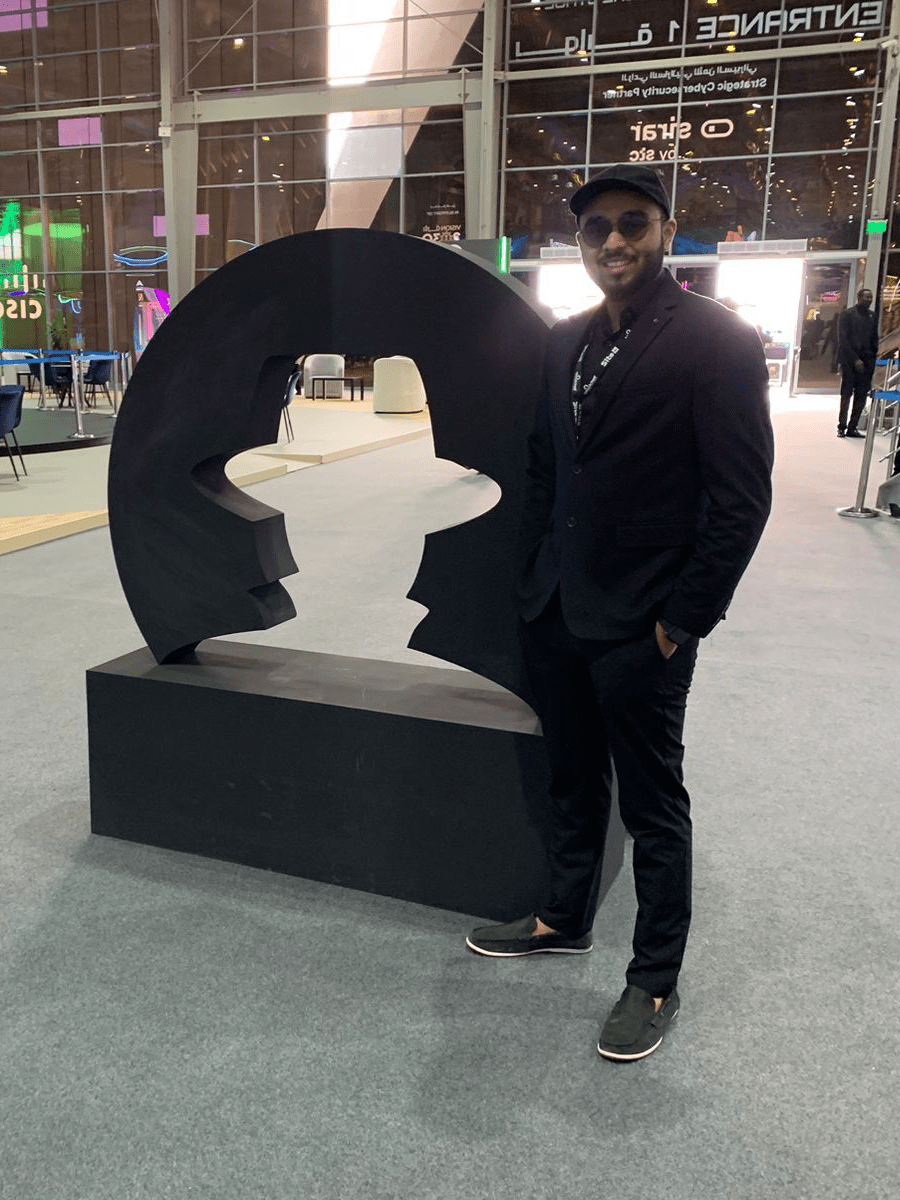According to JumpCloud, around 74% of breaches involve some degree of human error, underlining the critical role that employee behavior and awareness play in combating social engineering.
Farzan Mohammed started the presentation by outlining the growing risks social engineering poses. He explained that, at its core, social engineering manipulates human behavior to gain unauthorized access to systems or information. Drawing on recent data breaches, Farzan demonstrated how attackers target individuals within organizations, bypassing even the most robust technological defenses.
He followed by unpacking the innovative techniques used in modern attacks. He highlighted how adversaries now employ artificial intelligence and big data to gather detailed personal and professional information about their targets. This intelligence allows attackers to tailor phishing emails, fake calls, and other scams that are nearly indistinguishable from legitimate communications. A startling example included a case where AI-generated voices mimicked a CEO’s tone to authorize a fraudulent transaction—a chilling reminder of how advanced these schemes have become.

According to JumpCloud, around 74% of breaches involve some degree of human error, underlining the critical role that employee behavior and awareness play in combating social engineering.
Farzan Mohammed started the presentation by outlining the growing risks social engineering poses. He explained that, at its core, social engineering manipulates human behavior to gain unauthorized access to systems or information. Drawing on recent data breaches, Farzan demonstrated how attackers target individuals within organizations, bypassing even the most robust technological defenses.
He followed by unpacking the innovative techniques used in modern attacks. He highlighted how adversaries now employ artificial intelligence and big data to gather detailed personal and professional information about their targets. This intelligence allows attackers to tailor phishing emails, fake calls, and other scams that are nearly indistinguishable from legitimate communications. A startling example included a case where AI-generated voices mimicked a CEO’s tone to authorize a fraudulent transaction—a chilling reminder of how advanced these schemes have become.

The Weaponization of Social Media and Deepfakes
Farzan Mohammed highlighted one of the most concerning trends in cybersecurity: the exploitation of social media and deepfake technology. Attackers now monitor employee activity on platforms to identify potential vulnerabilities and craft highly convincing bait. Farzan detailed how these tactics are used to manipulate trust, particularly in virtual environments, where deepfakes can simulate credible personas in meetings or presentations.
The session also featured interactive elements that drove home the reality of these threats. Participants were tasked with analyzing phishing emails and fake login pages to identify subtle red flags. Many attendees, including seasoned professionals, were surprised by how easily they could be deceived by sophisticated attacks. This exercise underscored the pressing need for heightened vigilance and advanced detection strategies.
Employee Education: A Key Defense for Saudi Organizations
Farzan emphasized that combating social engineering requires tailored employee education. They advocated for training programs designed to address the unique risks faced by each organization. Farzan also recommended integrating AI-driven threat detection tools to monitor user behavior and flag unusual activity in real-time.
The presentation also connected these insights to the Kingdom of Saudi Arabia’s cybersecurity priorities. With industries such as healthcare, finance, and critical infrastructure rapidly digitizing, Saudi businesses are increasingly targeted by social engineers. Farzan encouraged organizations to take a proactive approach, combining education, technology, and a culture of vigilance to fortify defenses.
As the session concluded, the message was clear: while technology is vital, people are the first line of defense. Cybersecurity must address human vulnerabilities, ensuring every employee actively contributes to the protection of their organization. This presentation served as a powerful call to action, emphasizing the collective responsibility required to thwart social engineering attacks.
This presentation wasn’t just informative—it was a call to action. It reminded everyone in attendance that defending against social engineering is a collective effort, requiring continuous awareness and adaptation.

The Weaponization of Social Media and Deepfakes
Farzan Mohammed highlighted one of the most concerning trends in cybersecurity: the exploitation of social media and deepfake technology. Attackers now monitor employee activity on platforms to identify potential vulnerabilities and craft highly convincing bait. Farzan detailed how these tactics are used to manipulate trust, particularly in virtual environments, where deepfakes can simulate credible personas in meetings or presentations.
The session also featured interactive elements that drove home the reality of these threats. Participants were tasked with analyzing phishing emails and fake login pages to identify subtle red flags. Many attendees, including seasoned professionals, were surprised by how easily they could be deceived by sophisticated attacks. This exercise underscored the pressing need for heightened vigilance and advanced detection strategies.
Employee Education: A Key Defense for Saudi Organizations
Farzan emphasized that combating social engineering requires tailored employee education. They advocated for training programs designed to address the unique risks faced by each organization. Farzan also recommended integrating AI-driven threat detection tools to monitor user behavior and flag unusual activity in real-time.
The presentation also connected these insights to the Kingdom of Saudi Arabia’s cybersecurity priorities. With industries such as healthcare, finance, and critical infrastructure rapidly digitizing, Saudi businesses are increasingly targeted by social engineers. Farzan encouraged organizations to take a proactive approach, combining education, technology, and a culture of vigilance to fortify defenses.
As the session concluded, the message was clear: while technology is vital, people are the first line of defense. Cybersecurity must address human vulnerabilities, ensuring every employee actively contributes to the protection of their organization. This presentation served as a powerful call to action, emphasizing the collective responsibility required to thwart social engineering attacks.
This presentation wasn’t just informative—it was a call to action. It reminded everyone in attendance that defending against social engineering is a collective effort, requiring continuous awareness and adaptation.

See also:
